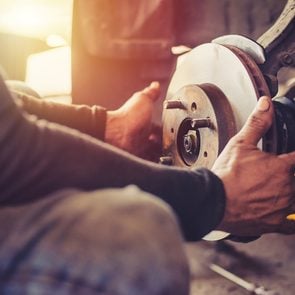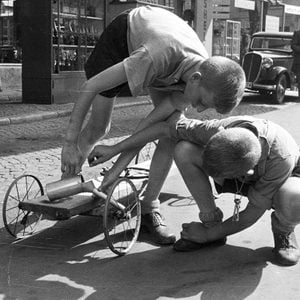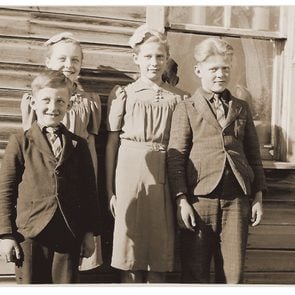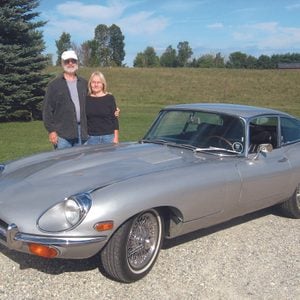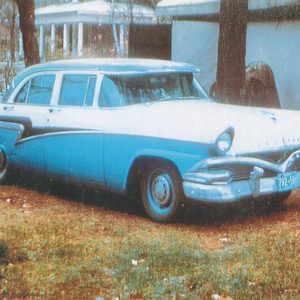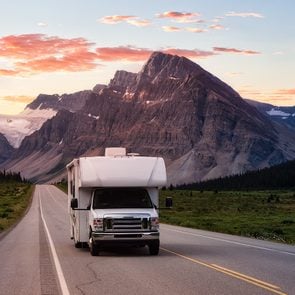Brakes are one of your car’s most essential safety systems. Never disregard grinding noises while driving or braking. When it comes to your car’s brakes, it’s always better to be safe than sorry.
Fortunately, most brake noises are considered normal and do not indicate a problem. Constant or strange grinding noises can be a sign that your brake hardware simply needs to be lubricated, or it can be a warning one or more brake system components are worn out or need servicing.
Here are four possible reasons your brakes are grinding:
Worn-Out or Poor-Quality Brake Pads
- Loud metal-to-metal grinding when stopping usually indicates the brake pad friction material is worn or has dislodged from its metal backing plate, to the point where the metal is digging into and scoring the rotor.
- Lack of proper brake caliper lube or missing shims between the brake pad’s backing plate and caliper piston will cause them to rub against one other, causing a grinding noise when stopping (as well as rattle while driving).
- Low-quality brake pads contain excess metal and fillers that scrape against and damage the surface of a rotor. They also have poor corrosion fighting properties that result in significant rust build up on the calipers and rotors, which can produce a loud grinding noise when slowing.
Replacing brake pads and rotors can be a DIY project. Do a little research to find highly-rated pads and rotors for your car and the type of driving you do.
Caliper Hardware
Worn, missing or broken brake caliper hardware, especially mounting bolts and shims, can cause grinding two ways:
- A brake caliper not fully secured to its support bracket because of loose or damaged hardware can drag and rub on the rotor, producing a grinding noise while driving and stopping.
- Dry, corroded caliper mounting slide bolts can bind and grind when applying the brakes. Binding slide bolts also cause the pads to drag on the rotors, causing them to overheat, grind and wear unevenly and more quickly.
Servicing caliber hardware when installing new brakes can be a DIY fix. Carefully remove rust, dirt and debris from the caliper. Remove and clean all hardened steel parts (caliber slide pins) by soaking them in non-chlorinated brake cleaner (not degreaser) and use a plastic brush. Do not “break” the hardened finish by cleaning with a file or wire brush.
Replace all brake mounting hardware (anti-rattle, spring clips and shims) when installing new pads. Lubricant the slide pins and caliper contact points with the appropriate high-temperature brake grease.
Brake Rotors
- Overnight, a thin layer of rust can form on a rotor and cause a grinding noise. Also, a change in temperature can make brakes grind. Once brake pads and rotors heat up, this noise stops. However, rotor surfaces heavily corroded and pitted from sitting for weeks without being driven (especially in areas of high humidity), poor quality brake pads or accumulated mud and road salts can cause grinding while stopping.
- Rotors that are glazed (smooth and shiny) due to cheap brake pads or scored from excessive wear and tear can also produce a grinding or scraping noise.
- A stone, rust flaking from a rotor or some other foreign object jammed between the rotor and pad or rotor and brake backing plate/dust shield will also make a loud grinding sound while driving or stopping.
Removing minor surface rust is a DIY task. However, even if a rotor is within manufacturer’s minimum thickness refinish specifications, it’s always better to replace rotors if they show any major pitting or wear.
Wheel Bearings
A faulty hub bearing may wobble, causing excessive rotor runout that results in uneven brake pad wear. Consequently, the brakes grind or squeal, or pull to one side when stopping. Wheel bearing replacement is best left to a professional.
Next, check out nine more strange car noises—and what they could mean.

Reader’s Digest Canada: Let’s start with the obvious: what is agoraphobia?
Melanie Badali, psychologist: The common oversimplification is that agoraphobia is a fear of leaving the house, but it’s more complicated than that. You could almost say that agoraphobia is a fear of being in situations that will cause panic; this feeling of I’m going to be in this situation and I’m going to be trapped. It has to do with enclosed spaces—public transit, elevators, airplanes, lineups—but it’s not just the fear of one particular setting, which would be a more basic diagnosis. When diagnosing agoraphobia, we are looking for two or more environments where the person experiences the fear.
What else are you looking at from a diagnostic perspective?
The physical symptoms are often similar to a panic attack: rapid heartbeat, trouble breathing, dizziness. And then a person will probably report that they are unable to do things or be in situations that used to feel okay. There is a sense of your world getting smaller and smaller. With all phobias, it needs to be persistent: at least six months of the same issue. There needs to be an interruption of a person’s ability to function in day-to-day life. And then we’re looking for an overestimation of the threat and an underestimation of coping ability.

After two years of COVID-related confinement, have you seen or do you expect an uptick in agoraphobia diagnoses?
We know that COVID has caused an uptick in stress and anxiety, but part of agoraphobia is fear being out of proportion to risk, and that doesn’t necessarily line up with the fear of public spaces during the pandemic, where the threat was real. I think that most people who are anxious about re-entering society after COVID will take small steps and realize that it is not actually that scary. They will have good experiences out in the world and anxiety will subside, so you won’t have the persistence I mentioned.
So there’s no such thing as COVID-induced agoraphobia?
It is possible that the pandemic created conditions that could trigger a person with high susceptibility (a family history, for example). At this point, we just don’t have the data to know. But again, if a person is scared of getting COVID, that is a different thing. With agoraphobia, the fear is that they might actually die from panic (like, a racing heart will lead to a heart attack). Or they are worried that they might lose control (start trying to smash the windows on an airplane, for example). Some people will have the insight to recognize that their fear is disproportionate to the situation, but the reality is that for most people who come to see me, they are there because a loved one has said to them, “I’m worried about you.”
What does treatment for agoraphobia look like?
I am a cognitive behavioural therapist, so the goal is actionable solutions. Often that means exposure therapy—if you’re afraid of being in an elevator, we will start by standing and just watching the doors open and close, and then step in and step out. It’s gradual, and it only works with repetition over time—like practising the piano. The hope is that as well as realizing that their fear is overblown, people will remember the positives associated with pushing past their fear.
Now that you know what agoraphobia is, check out this expert advice on overcoming a fear of flying.
I was born in rural Nova Scotia in the 1920s. Like many others, I have seen and enjoyed the changing times and advancements of our world, but I have also been thinking about things that were important to us back in the Great Depression era. One of those items was the old stove in the kitchen where I grew up.
The stove was wood-fired and placed near an inside wall of the kitchen with a woodbox nearby. It was black-topped, with a warming oven in the back and a water tank on the right side.
That stove had many uses. When Mother needed to iron clothes, she would put two or three “sad” irons (flat irons) on the stove to heat. There was always a fire in the stove, except in the warmest of weather. Mother had a wooden handle with a cast-iron base that would clip into the sad iron. As one iron would cool, she’d place it back on the stove and take a hot one. There was also always a kettle steaming on the stove to add moisture to our home; the kettle had an oyster shell inside to collect the mineral deposits from the water.
Every fall, we would peel and section apples, put them on strings and hang them behind the kitchen stove until dry. These would keep for months and be used to make delicious apple pies all winter.
My father also made homemade sauerkraut out of yellow turnips. He’d fill a big crock pot with turnips and layers of coarse salt. He would then wash a five-pound rock, place a big plate on top of the kraut, put the rock on top of it and place the whole thing behind the stove to cure. Speaking of behind the stove, in winter, when we came in from the cold, we’d place our mittens in the warming oven to dry. Sometimes, we would even crawl behind the stove ourselves to get some extra heat to warm up our bodies as well.
On our farm, when the Depression came, the car was put into the barn and horses were used for transportation instead. I used to accompany my Dad when he took grain to the Balmoral Grist Mill, which is now a museum, to be ground into flour, oatmeal or cattle feed. The kitchen stove would be used to cook the oatmeal all night in a double boiler to make delicious hot oatmeal for breakfast.
One year, Dad brought home the hulls from the grain. The hulls were put into a six- or seven-gallon crock pot that was filled with water and placed behind the stove. When the hulls were strained from the liquid, it was again placed behind the stove and left in the warm place until it turned into a gelatin-like substance. I remember they called it “zounds” and it was delicious served with cream and sugar.
I also remember my mother putting some kind of grains on cookie sheets and roasting these in the oven. They would make hot, coffee-like drinks in the cold weather.
Mother would also bake delicious biscuits and other goodies in the oven—with no thermometer, she gauged the temperature of the oven by putting her hand in it.
One winter, Dad made me a pair of skis. He took maple lumber, shaped the skis and put the front of them in the warm water in the tank at the end of the stove. I don’t remember how many hours or days he left them in the water, but later, he removed them and put them in some kind of mould to curve the front of the skis. He left them there to dry until they kept their shape.
One last vital task the old kitchen stove performed was our Saturday night bath. The big copper boiler was brought in and filled with water to heat, then the tub was brought into the kitchen and baths were enjoyed!
The kitchen stove—what a wonderful role it played in our lives. I suppose the only downside of it all was that growing up, I was the one who had to keep the woodbox filled!
Fancy another walk down memory lane? Here’s what laundry day was like in the 1930s.
When I first met him, my husband Rod had been an admirer of vehicles, especially muscle cars of the ’60s—the cars of his youth. A wealth of information, he could name the year, make and model of almost any car, even if we saw it in passing on the opposite side of a four-lane highway. This was amazing to me, as I tended to identify cars based on their size and colour. Whenever we passed a local “Show ’N Shine,” we always stopped to have a look around. Finally, in the spring of 1997, the year he turned 50, Rod graduated from admirer to owner with the purchase of a 1967 Camaro convertible. When we first went to look at the car, it was sitting in the corner of a farmer’s Quonset hut, covered in dust, and had not been driven in years. But it fired right up and, in a matter of minutes, we decided to purchase it. The following day, we returned with a cheque and Rod proudly drove it home.
It was, of course, in need of some TLC. The first order of business was to replace the torn ragtop and front seats. Once that was done, we spent the summer cruising in our new toy. The reactions we got while driving that car were amazing—people were always honking, waving, or giving us a big thumbs-up. As winter approached, the car was relegated to the garage and Rod began searching for parts to complete the restoration. We made countless trips to David T’s Auto Center in northeast Edmonton; bought parts locally wherever we could find them, and purchased hard-to-find items from as far away as California and Georgia.
As the years passed, Rod spent many hours loosening old rusty bolts; cleaning and polishing, and replacing worn parts—being careful to never misplace so much as an original bolt. There were frustrations and occasional four-letter words, as knuckles were scraped or newly acquired parts didn’t fit as planned. At the end of a busy day, though, Rod liked to sit back with a cold, well-deserved beer and admire the latest improvement to the Camaro. “Car gazing,” he called it.
Once most mechanical issues had been addressed we began to take longer road trips—to Vancouver Island, California, New Mexico, Oregon, Washington and Montana. We’d pack an amazing amount of stuff into that little car, and then throw a set of golf clubs on top of the pile in the back seat to help hold down the load as we cruised with the top down. We soon bought a small tent trailer—a Kamperoo—that we hauled on more holidays.
In an old car that still had many original parts, some problems were to be expected. The most memorable one occurred in Glacier National Park, Montana. We had driven to the summit of Logan Pass, where we spent a beautiful day hiking. We decided to put the convertible top down for the descent and partway through the process, the original hydraulic motor that powered the top gave up the ghost, forcing us to drive down the mountainside with our roof conspicuously at half-mast. Nothing that a friendly neighbourhood mechanic couldn’t fix—and we managed to find one who did.
Sadly, Rod passed away in 2014. I still enjoy driving that 1967 Camaro convertible, although the trips are shorter and always bittersweet. I will soon pass the car along to Rod’s son and then he, too, will be able to experience the incomparable joy of the open road, of the sun and wind on his face and, hopefully, the pleasure of making improvements to a car that’s now passed 50, but still rarin’ to go.
Next, check out an impressive 1967 Mustang Coupe restoration.

A Girls’ Trip to Manitoulin Island
Our group of five is part of a larger group of ladies who meet once a month in Muskoka, Ontario. These monthly get-togethers ensure that we get time out of the house regularly and we all enjoy spending time with friends. Each month, someone in the group takes a turn to plan and host an event. We have already done quite a bit, from playing paintball, beach activities, skiing and hiking to bonfires, dockside parties, cookie exchanges and even a limo ride while wearing prom dresses!
With limited time together in person due to COVID restrictions, we planned this trip for just five people to stay in a bubble. Our whole vacation was meticulously pre-planned, booked and paid for before we left, to ensure we were able to get the most out of the trip in these odd times. The RV was the perfect solution for a much-needed getaway. This trip ended up being the most fun adventure I have had all year.

French River
After picking up the RV in Bolton, Ontario, we met up with the rest of our group in Muskoka and headed to our first destination: the French River, which flows 110 kilometres from Lake Nipissing west to Georgian Bay. Although we had decided early on that we were not going to attempt to reverse this beast of a vehicle, that proved to be impossible as we had to back it into our very first campsite! Everyone helped to navigate the RV into place, including the park staff. We chose to stay at a remote private campground where the hosts were friendly and helpful, and they got us settled in and accustomed to the RV way of life. Our first night included a cookout and bonfire before we nestled into our beds.

Morning came early, and we were up by around 7 a.m. We started our day off with some yoga by the water, and we then rented a tin boat to enjoy the French River’s fall foliage, which was breathtaking.

Manitoulin Island
The next day, we travelled onwards to Manitoulin Island and had lunch in Little Current. The afternoon was filled with a rigorous hike up the Cup and Saucer Trail. The views were expansive over the colourful fall treetops, as far as the eye could see. We stayed at a private campground once again and were thrilled when we were given a site right on the water looking out at Lake Mindemoya. This location was a great base from which to explore the rest of Manitoulin, and we decided to stay there two nights. We enjoyed bonfires, walking along the water and, when it rained, watching a movie on a laptop in the RV.

Manitoulin Island is a gem of a location to travel to. Further adventures enjoyed there included a picnic on Providence Bay Beach, shopping in Gore Bay and hiking at Bridal Veil Falls. Before we knew it, it was time to board the Chi-Cheemaun Ferry in South Baymouth and head to Tobermory.
Tobermory
After having travelled there many times, Tobermory is one of my favourite places in Ontario. Along with the breathtaking views, there is such a variety of things to do.

Unfortunately, due to rough waters caused by heavy winds, we were unable to go out on a boat tour of the shipwrecks, or make it to Flowerpot Island. Instead, we hiked Devil’s Monument Trail, where a similar flowerpot structure was hidden among the trees. What is especially impressive is the surrounding water in the area, which is crystal blue—like the ocean! But it is freshwater of course, as Georgian Bay is connected to Lake Huron. The water was too cold to swim, but we hiked to the Grotto for some incredible views and enjoyed a picnic on the Bruce Trail.
Check out the best hikes in Canada.

The experience of five girls navigating and managing our mammoth RV was surprisingly smooth, but not without a few challenges. As the sink in the RV filled up and would not drain, it was clear we would have to dump our sewage reservoir. This is something we worked very hard to avoid, as no one on the trip was interested in taking on this unappetizing task. Despite that, we did come prepared for this possibility and packed plastic gloves and a septic tank cleaner. “Any volunteers?” I asked hopefully, not wanting to take it on all by myself. Thankfully, there was one gracious volunteer and the task turned out to not be as nasty as we thought. The rest of the gang was eager to take pictures of the stinky affair and laugh as we learned this new skill.
The village of Tobermory is very quaint, with galleries, shops and a great restaurant that had a tropical feel to it. We ate outside on bar stools overlooking the water, despite the cool October weather.
Discover more hidden gems in Ontario.

We made the most of our trip and took advantage of every opportunity, such as the day we stopped on the side of a dirt road on the way back from a hike. We may have been a little lost that day but nevertheless we found what appeared to be wild apple trees. Hoping they were in fact wild, and that we weren’t trespassing, we all picked plenty of apples and used them to make some delicious treats—apple crumbles, muffins and pies just to name a few!
Overall, the trip did not disappoint. We had plenty of quality girl time, did lots of exploring and had fun adventures—there was never a dull moment. We laughed, hiked, shopped, made delicious meals together and enjoyed every minute of our RV experience.
Circumnavigating around Georgian Bay and travelling over 1,000 kilometres in an RV, while respecting COVID restrictions, turned out to be a grand adventure. Vacationing close to home with friends proved to be so much fun!
If you live in Ontario, why not plan your own adventure in Manitoulin and Tobermory? Or if you live elsewhere in Canada and are planning a trip to Ontario, this wonderful region may be something you want to add to your travel itinerary!
Next, check out 10 national parks every Canadian should visit.
The mere thought of your car plunging off a bridge into the icy water below can send shivers down your spine. But with proper planning you can increase your chances of survival. Follow these tips to escape from a sinking vehicle from Jason Lyman, assistant chief of the Islamorada Fire & Rescue Department of Village of Islands, Florida.
Don’t panic
Though it’s a terrifying situation to be sure, the key to making it out of a sinking car is to focus and keep your wits about you. Panicking will only waste time that you do not have.
Skip mobile communication
Trying to call 911 to come and rescue you isn’t your best move because the responders probably won’t get there in time—and time is of the essence.
Unlock the doors
If it’s dark, first turn on your interior lights then unlock your doors. A vehicle’s electronics system should work for some time after your crash.
Plot your escape
Your car will stay afloat for a short time, so use this opportunity to escape. Remove heavy clothing, roll down your windows, and swim away as fast as you can. Do not worry about trying to save your purse, your wallet, or any other personal items; survival is the name of the game. Plus, if it is winter, your risk of hypothermia increases the longer you’re in the water. The quicker you can get out, the better.
Wait to open the door
This sounds scary, but you won’t be able to open the door until the car is fully submerged: rising water puts too much pressure against it. Once the pressure inside has equalized, the doors should open, though sitting and waiting for this to happen can cause panic. Concentrate on your next move instead.
If you can’t open the door, break a window
If the electrical system has already failed, you can try kicking the window out. It is wise to keep a tool like a centre punch or something similar accessible in your car at all times. Many of the products designed for breaking glass can also be used to cut your seat belt. Use it on your windows, not the windshield—it is laminated safety glass, and you won’t break through. Also, some newer vehicles have installed laminated glass on the sides, and/or thick window tinting may have the same properties. Familiarize yourself with the ins and outs of your car before there is an emergency.
Take a deep breath
Once the water has risen to chin level, grip the steering wheel for leverage and take off your seat belt. Take a slow deep breath and hold it in.
Practice becomes perfect
Rehearse this routine as you would a fire drill: this is another case where practice creates muscle memory. Ingrain these steps in your head so that you can save valuable time.
Next, check out 10 driving tips to stay safe in wet weather.
Reader’s Digest Canada: The federal government has set some ambitious targets for electric vehicle (EV) use: 10 per cent of new cars purchased by 2025 must be EVs, and 30 per cent by 2030. How are we doing?
Josipa Petrunic, executive director and CEO of the Canadian Urban Transit Research and Innovation Consortium.: We are currently between three and four per cent. Our government targets are aggressive but not impossible—if we make some changes. Over the last few years, the focus has been on subsidies and other financial incentives: if you buy an EV you get a tax write-off. That is one piece of the puzzle, but it’s not enough. We have to start pricing roadway, which could be incredibly effective, but it’s politically unsavoury. (Find out 12 things you’re not claiming on your taxes—but should be.)
Do you mean road tolls?
Exactly. You’d have to pay to enter any major city, and you would pay less or not at all if you have an EV. In the U.K., tolls for entering London have been extremely effective, both in cutting down congestion and in reducing car use and getting more people onto transit. If the overall goal of emissions reduction is hitting our Paris Agreement targets and saving the planet, only getting those who can afford it into an EV is not going to move the needle.
We know EVs are better for the planet, but how much better?
Using a zero-emissions vehicle or giving up a car altogether is the most effective thing a person can do to reduce their carbon footprint, other than having fewer children.
Along with expense, one common reason for EV hesitancy is the lack of charging stations.
We have enough stations to handle the number of EVs on the road today, but not enough if we were to see more mainstream adoption. But, also, the vast majority of charging happens at home: you plug in your car at night and in the morning you’re good to go.
Good to go how far?
That depends on battery power, which varies from vehicle to vehicle. Overall energy capacity of batteries has improved, though. The 2015 Nissan Leaf, which is an entry-level EV, got about 200 kilometres on one charge. Now it’s about 250 to 300 kilometres, so enough for day-to-day life but not enough for hopping on the highway and heading out of town.
That’s no small issue, given our national enthusiasm for the great Canadian road trip.
Actually, 90 per cent of driving life is short-range trips—commuting to work, driving to Costco, going to a soccer game. We need to convince Canadians to choose cars that suit those day-to-day needs. Then, for the other 10 per cent of their driving life—say, the rare drive to a cottage—they may consider car-rental or ride-sharing programs.
The Automotive Parts Manufacturers’ Association is spearheading a new project backed by 335 companies to create an all-Canadian EV. Is that a promising sign?
It’s exciting to see new projects getting attention and funding. But I also want to point out that we have been manufacturing electric buses in Canada for over half a decade. Maybe they’re not as sexy as a Canadian Tesla, but if we want to talk about change, transit is the way forward. People buy cars one by one, but cities buy public transit vehicles in mass quantities. With public transit, we’re not talking about a curve that goes up in tiny increments; we can see the line shoot up.
Next, find out what Canada’s ban on single-use plastics will mean for Canadians—and the environment.
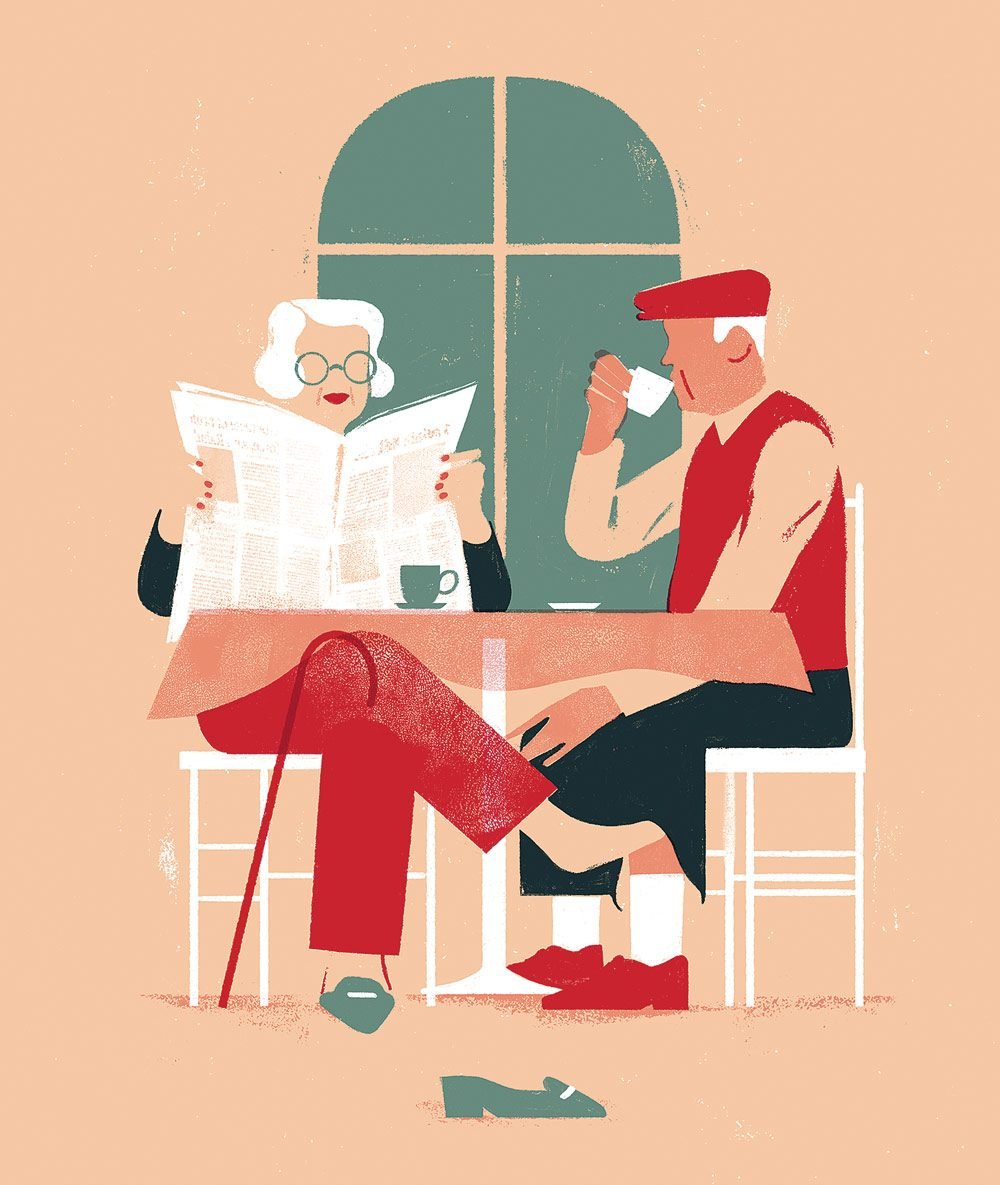
Still got it
I fear I’m not quite the raven-haired “hottie” I once was. Oh, my hair is still raven coloured, sure, but now when I look in the mirror, I sometimes see the ghost of Alan Rickman looking back at me. Not from Truly, Madly, Deeply. From the Harry Potter films. He really rocked that aging-goth look. But, just like the late Alan Rickman, without my L’Oréal hair colour I’m a silver fox too, which is only natural, seeing as I’m north of 60. But that doesn’t mean I don’t still feel pretty hot sometimes.
Few of us talk about it openly, much less flaunt it, but sexual desire beyond the sixth decade is a fact of life. It’s in this spirit that prominent French psychologist and bestselling author Marie de Hennezel approached the topic of sex among seniors in her 2017 book A Frenchwoman’s Guide to Sex After Sixty. De Hennezel, now in her 70s, has written a dozen books on aging and been translated into 22 languages. She mostly writes about heavy subjects like spirituality and dying, so when she turns her attention to sexuality, she doesn’t take it lightly either.
There’s no age limit to enjoying love, she writes, because “the heart does not age,” and the same goes for lovemaking. She argues that if we adapt sexual activity and adjust our expectations to better suit our aging bodies, we can look forward to rewarding sex.
While this might not sound radical, it still deserves attention. In Western culture, the depiction of senior sexuality has traditionally been abandoned to farce or burlesque comedy, mostly as cringe-inducing, inappropriate or even aberrant behaviour. (Think Blanche, the vain and easily aroused middle-aged southern belle whom no one took seriously in the 1980s sitcom The Golden Girls, or the British skit comedian Benny Hill, who made a career of mostly playing a so-called dirty old man.) It’s almost as though once you are old enough to be a grandparent, you are expected to pass the baton of sexuality to the younger, more fertile generation. It’s the natural, mature, even moral thing to do.
Longing for love
But times are changing. Maybe it’s just that big, bulging baby boomer cohort sashaying its way into old age and recalibrating everything in its path. Maybe it’s just the inevitable advance of the sexual revolution: birth control to LGBTQ rights and, now, senior sex. Award-winning TV shows like The Kominsky Method, starring Michael Douglas and Alan Arkin, and seven-season hit Grace and Frankie, starring Jane Fonda and Lily Tomlin, have been trailblazers. The shows’ main characters are knocking on their 80s and are still interested in sex and romance. What’s new is that they aren’t caricatures of frustrated sexual desire; they are complex characters with a rich range of thoughts and sensitivities, of misgivings and hesitations, of humour, courage and conviction. They long for love because, even in old age, they are fully human.
De Hennezel is fully aware that many people over the age of 70 are done with sex. Even with the most satisfying sexual history behind them, they’ve reached a point where they are simply more interested in their grandchildren or gardening or Netflix than any new dalliance. They don’t have the physical or emotional energy. Voluntary celibacy can be a perfectly valid lifestyle choice. What’s important is that seniors feel they have a choice and can exercise it.
De Hennezel writes that 12 per cent of people over 60 years old say sex is a source of great pleasure. But she’s more interested in the 36 per cent of seniors out there who say they would like to have great sex, some of whom may lack the confidence to pursue it. They fear they are just too old. They’re wrong, she says, but senior sex is such a taboo subject that they don’t know where to turn for advice and support.
Sure, there are common aging issues that can make the more vigorous sexual workouts of youth a hassle or even a hazard. Who among us over-60 lovers hasn’t found themself wondering, “Is this position going to break my hip?” A long list of factors can throw cold water on Peggy Lee’s fever: bad knees, weak wrists, lower back pain, arthritis, osteoporosis, weight gain, heart conditions and so on. But the good news is, whatever your ailment, there’s a position for that. The point is to experiment. You don’t have to feel like you’ve done 50 push-ups the morning after. And, as with all good sex, an agreed-upon safe word is always recommended, like “ouch.”
In every seniors’ residence, people flirt, develop crushes, have blooming romances, ignite their desires and fall in love, and it feels just as sweet and exciting as it did when they were teens. But, while TV and film may be taking the lead in acknowledging this, wider society lags far behind. Not respecting the sexuality of older people is, to quote de Hennezel, “quite simply a form of abuse.” Much of society still squirms at over-60 sex, often ridiculing it with adolescent humour: see jokes about predatory cougars or the aforementioned dirty old men. Buying into these viewpoints is how we suppress the senior sex drive.
A senior sexual revolution
Another hurdle, though, is that we internalize age shaming. We no longer feel physically desirable. It’s the price we’ve paid for participating in a culture that fetishizes the aesthetics of youth. It’s all fun and games until we begin to notice our own aging. Then, too often, we are appalled. We dread exposing our creped skin, crow’s feet, sagging bellies and breasts and butts to each other. The physical signs of aging can make us feel humiliated or embarrassed, like we’ve done something wrong. This is particularly true for aging women, of course, who often watch men their own age chase after younger generations. No wonder they are willing to pay a high price, quite literally, to fight the evidence of time.
De Hennezel seems to believe it’s time we saw our aging reflections in a new light. With genuine enthusiasm, she reminds her readers time and again of the real beauty found in the seasoned face and body. This isn’t some kind of social-conditioning program designed to convince us that loose jowls are just as attractive as high cheekbones and a pert chin. More like a reminder that attraction has always been a matter of sublime subjectivity. A good thing, too. Otherwise, everyone would be courting the same 10 per cent of the population.
When we get to know someone, they often begin to change before our eyes, and how we see them is gradually affected by how we feel about them. Our memories and mutual experiences shape what we see and don’t see, what attracts us and what doesn’t attract us. As time goes on, beauty is increasingly a work of the imagination, more like an atmosphere than an actual place. Nowhere is that subjectivity more gloriously evident than in an old married couple who look at each other and love what they see.
At the same time, this new senior sexual revolution isn’t being driven by old married couples but their singleton friends. A markedly growing demographic in North America is the single senior; people are living longer, and the divorce rates among retired couples have doubled in the last few decades. For single people no longer preoccupied with work and raising families, it can also be the loneliest time of their lives. Enter online dating sites that target seniors. Internet dating among the aging is a booming business. It’s not all about sex, of course. It’s also about companionship. But those who manage to find a place for sexuality in the third act of their lives are the undisputed lucky ones. There’s nothing like a rush of endorphins to improve your circulation.
De Hennezel suggests aging lovers consider backing away from what she calls “performance-based sex” because it places too high an expectation on the physical strength and endurance of the partners. She thinks that means placing less emphasis on genitalia and sexual intercourse. This is partly in response to some common sexual challenges of aging, such as inadequate vaginal lubrication and erectile dysfunction. Sure, there are solutions for these problems. Even so, she advocates a form of eroticism inspired by eastern cultures, tantric and Taoist, that simply doesn’t get hung up on physical exertion. They’re all about “slower-paced, more sensual, tender and playful sex.” That might even include old-fashioned oral and masturbatory sex and erotic massage therapy, maybe with a little ’60s soul music playing in the background for effect.
But different strokes for different folks. I confess I find the advice to shift away from coitus, well, premature. As a Canadian living in a colder climate, I’m happy to enjoy a little friction under the covers for as long as I can. I’m not saying that “slow sex,” “soft penetration” or “making affection” won’t ever cut it with me. Absolutely, I’m looking forward to tantric sex someday, lying still, side by side for hours, simply touching each other’s bodies with fingertips. Though, right now, I fear the only thing that would be buzzing after an afternoon of tantric touching would be the to-do list on my kitchen counter. So maybe when I have more time on my hands. Like when I’m 90.
Next, discover 13 secrets your urologist wants you to know.

When I was a teacher, I’d ask students to find a word in the dictionary, give the meaning and use it in a sentence. My favourite answer was: “My word is pregnant. It means carrying a child, like the fireman went up the ladder and came down pregnant.” —Orville Cole, Dartmouth, Nova Scotia
My six-year-old couldn’t remember the word “tomorrow” so she called it “nexterday.” —@kbrough
We gave our grandson a fishing pole for his fourth birthday. When he opened his present he exclaimed, “Wow! A fishing machine.” —Bonnie Hughes, North Webster, Yukon
My daughter has just learned how to wiggle her eyebrows. She asked me if I could do it, so I did. Then she said, “Wow, you can do it so fast! It must be because you only have one eyebrow so it’s easier.” —@sharrzeor
You know you’ll be subjected to many years of practical jokes when your toddler swings open your washroom door and points a pair of binoculars right at you. —Ashley Ashfield, Hampton, New Brunswick
My seven-year-old asked if I could get him something so he could send a letter the old-fashioned way. Paper? An envelope? A stamp? No, he wanted his own email address. —@mommajessiec
I was babysitting my five-year-old granddaughter and as a treat I took her to McDonald’s to get an ice cream cone. When she finished, I asked if she enjoyed it. Her response was, “Yes, but now my tummy’s cold so I think I need fries to warm it up.” —Joyce Hellewell, Windsor, Ontario
When my son was young, he became vegetarian for a year, and we always thought it was because of his kind heart and love of animals. He’s a teenager now and just revealed it seemed like the only way out of eating the meatloaf they served at preschool. —Jessica Holmes, comedian
After our special Mother’s Day breakfast, I heard my three-year-old say to his sister, “Have you heard of Brother’s Day? It’s where you make your brother a really special breakfast to show him how much you love him.” —Tammy Tsang, Toronto
My son begged for a sibling for years and then it finally happened. When my daughter was one, she would pull toys out faster than we were able to put them away. I looked at her six-year-old brother and said, “What are we going to do with her?” He replied with a very serious face, “Keep her. I worked hard to get her here!” —Shawna Mathieson, Watson, Saskatchewan
During a conversation with my nine-year-old granddaughter, I told her that when I was her age our house was the first on the block to have a colour TV. She asked me, “What colour was it?” —Deborah Brettell, Williams Lake, British Columbia
Here, more grandparents reveal the funniest things their grandkids have said.

My 10-year-old daughter asked if we have to pick up her brother from school, noting, “He has to go to school tomorrow anyway.” —@bunandleggings
While playing with my four-year-old son, I picked up his Batman action figure and said, “I’m Batman, the Dark Knight.” He then picked up Superman and answered, “I’m Superman, the Sunny Day.” —Charline Agulto, West St. Paul, Manitoba
My kid tonight at bedtime, after I paused a beat when opening a storybook: “Turn the sound on, Mama.” —@cdellamore
I came home one day to find my then-three-year-old daughter watching TV with her father. She said, “Mommy! You’re a princess in a movie!” They were watching our wedding video. —reddit.com
My six-year-old daughter just told me she wanted to stay up later. I told her, “Okay, 10 more minutes.” Then she countered, “How about 40 more hours?” I think we need to work on negotiations. —@curiositybooked
It’s hailing. Or as my kid calls it, “crunchy rain.” —@lydiaykang
My 11-year-old son’s fingernails were neatly trimmed except for his thumbs, which were unnaturally spear-shaped. When I asked him about this, he said he needed them to play the ukulele in music class at school. —Maria Baranowski, Winnipeg
Every day my daughter regales me with the best stories about recess, and when I asked her once why recess is always so dramatic, she said, “Daddy, one recess can change the world.” —@dad_at_law
My four-year-old grandson: That tree is dead.
Me: What does that mean?
My four-year-old grandson: That means you have to charge it. —@esteestimler
When I asked my daughter why she didn’t like her school’s guided meditation, she said, “Because I don’t want people telling me when to breathe, that’s why.” —@jessicavalenti
My five-year-old thought it was living room and dying room as opposed to living room and dining room. No wonder mealtimes have been so stressful. —@davidwcochrane
I made my toddler a smoothie for the first time, and now she keeps asking for more “yogurt water.” —@coffeencrusts
My seven-year-old grandson talks continuously. I asked him if he thought his tongue would last him a lifetime. He replied, “They say I take after you, and you’re doing all right.” —Chas Gallant, Antigonish, Nova Scotia
My five-year-old asked where the app was on my phone for calling people. —@momsense_ensues
I was admiring my granddaughter’s new gold shoes and said to her, “I want a pair of shoes just like that!” She responded, “Nana, when these shoes get bigger, I’ll give them to you.” —Laurie Trayer, Hope, British Columbia
My three-year-old: Do you know what pregnant means?
Me: What?
My three-year-old: It means you can’t bend over. —@mycuriositylab
My three-year-old: “Mom, when I grow up, I want to be a cozy blanket. Or Santa Claus.” —@brisommwrites
Next, check out these silly struggles every parent will relate to.

